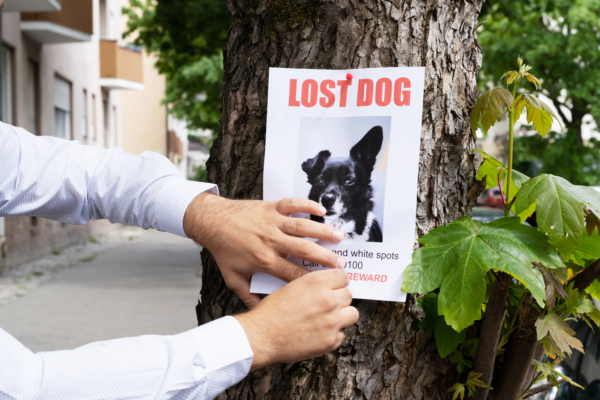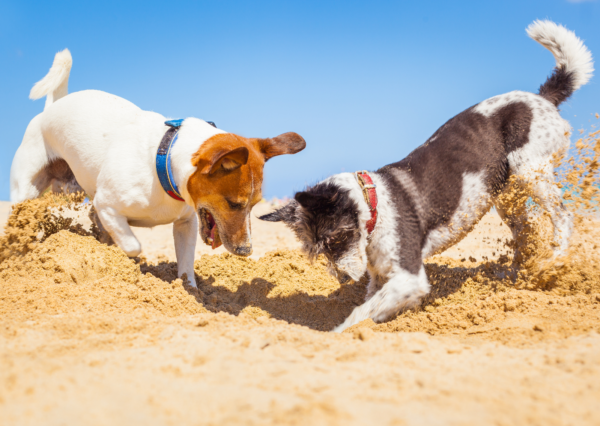Impulse control – mindset matters pt. 1 of 2
One of the more profound things I’ve heard Kay Laurence say is that positive reinforcement trainers need to be careful we are not just “overlaying clicker training principles on top of a traditional mindset.” In a traditional mindset, the primary teaching strategy is to reduce or eliminate unwanted behavior via positive punishment. Even when teaching something new, the traditional trainer typically starts by first punishing all other unwanted behaviors, which then sets up a negative reinforcement contingency for the desired behavior. Heeling, for example, is commonly taught by giving a collar correction every time the dog moves out of position, until eventually the dog learns the only safe place is close to the handler’s side. In this system, training commands become avoidance opportunities that mean: “do the safe thing, or else something icky will happen to you.” https://tromplo.com/course/control-is-an-illusion-rethinking-how-we-teach-for-impulse-control-6/
Positive reinforcement instead of positive punishment
Thankfully these days more people are turning to positive reinforcement instead of positive punishment. However, just because you are using treats and toys instead of a choke chain, does not always mean those treats and toys aren’t sometimes still being used to reduce or suppress behavior. Just ask yourself this: if the underlying goal of your training plan is to get a dog to stop doing something—stop pulling, stop barking, stop jumping, stop trying to eat the food in your hand—it’s maybe time to take a closer look. Are you using the promise those reinforcers represent to actually reinforce behavior? Or, are you overlaying clicker training principles on top of a traditional mindset: using the withholding or removal of those reinforcers to reduce behavior? Impulse control is a hotly debated term in the animal training world. For some, it is an outdated, and unhelpful construct. But for many others, teaching a dog to “self regulate” is the cornerstone of their entire training program. Without a doubt, I have seen people teach what they call impulse control with minimal frustration, and excellent results—if, by results, one means the dog is able to ignore certain stimuli, such as other animals, food on the floor, distracting smells, etc. When done well, there should be only a brief application of extinction and / or P-, quickly followed by R+, so that the learner catches on fairly quickly that moving away from the desired stimulus is the way to win the game. However, I have also seen so much bad training under the same banner, it has made me suspect that there may be something about our everyday understanding of the term that is getting in the way of our ability to be as objective about our training choices as we should be.
Go to YouTube and type in the words “impulse control + dog training.”
What you will see is example after example of dogs presented with something they clearly want, such as a food treat held out in someone’s hand, a water bowl, a toy, or entire meal—only to have the item snatched away the moment the dog moves towards it. Turn the sound off and just watch the body language. From the learner’s point of view, it is clear the lesson is confusing. Most dogs either escalate the behaviors that have worked for them in the past—biting at the hand, jumping, barking, pawing, etc., or you see them visibly deflate and disconnect—lip lick, yawn, shake off, and walk away. Watch again with the sound back on and, more often than not, the voice over will be saying something about “the importance of teaching a dog to control his or her impulses.” Rarely do you hear the person discussing what is really going on, which is that negative punishment is being used to reduce the behavior of trying to acquire reinforcement. When I watch these videos, my mind usually starts buzzing with questions. Is it really in our best interests, I wonder, as positive reinforcement trainers to instigate a rule structure where the goal is a reduction in trying to acquire reinforcement? In order for positive reinforcement to be effective, don’t we need dogs eager to enjoy what we have, and don’t we want them willing to try all sorts of things to get it? When we punish one response, such as pawing or nibbling at a handful of food, is there ever a danger of inadvertently punishing other responses that we may want more of later on the same cue of food held in our hand, such as offering behavior or problem solving? [youtube]https://youtu.be/fNozzEcYpPU[/youtube]
You don’t need negative punishment to teach impulse control
Negative punishment is not necessarily a harsh teaching strategy, which is why most of us do usually prefer it to positive punishment. However, I have encountered numerous dogs over the years that have formed habits of frustration and over-arousal–habits that seemed attached to the antecedents surrounding training in general. The trainer standing in a formal posture, the presence of reinforcement, the sound of a clicker, training props, etc.–all can become cues for unhelpful default behaviors like barking, snatching at food or toys, or offering a flurry of behaviors in a frantic way. To avoid some of these issues, I find it helps to be up front about exactly what quadrant I am intending to use to teach something, and why, so I can objectively weigh the pros and cons of how that choice may impact my learner long term. An “impulse” is defined as an uncontrollable inner urge. I often picture it as something like a neuron that fires in the brain that makes you do something without thinking. Bona fide impulsivity disorders are rare but can be clinically diagnosed by a qualified veterinary behaviorist. In the realm of neuroscience, impulses are, of course, being studied by qualified people all the time. So, I’m not saying impulses don’t exist. However, when most of us are talking about “impulse control,” we are not usually taking a vet behaviorist, or neuroscientist’s point of view. Nine times out of ten, if we are perfectly honest with ourselves, what we usually mean is we’d like our dogs to stop doing gross, loud, hyper, embarrassing, dog-like things.
Cultural fog
For some time I’ve suspected that impulse control, as it relates to animal training, has a fair amount of what Dr. Susan Friedman calls “cultural fog” surrounding it. Cultural fog is the mythology and misinformation about animal behavior and the best ways to train animals that typically is passed down trainer to trainer in the form of tradition, not behavioral science. It is telling, I think, that the two most likely places you will even hear the words “impulse control” are in the dog training world, and the horse training world. The term does not come up much, if at all, in either the zoological or marine mammal communities. Historically, dog and horse training are both much more closely tied to the traditional mindset, whereas marine mammal and zoo training comes more directly from applied behavior analysis. In just my lifetime, animal training has evolved, and is continuing to evolve, in all sorts of inspiring directions. However, for each brave step we have taken away from traditional mindsets, to this day, when training doesn’t quite go according to plan, the learner still tends to pay the price. In the words of Bob Bailey,“training often fails because people expect way too much of the animal and way too little of themselves.” Case in point, I recently did a consult for a promising young search and rescue dog who consistently did her job well, running long searches over rough terrain for hours at a time, always finding her subjects in the end; but, due to a fluency glitch, she was not always reporting back to her handler correctly 100% of the time. The advise given to this dog’s owner by several experts in the field was surprising to me. He was not told to look for holes in how the indication behavior was taught in the first place. Instead it was implied that she was “messing around” on her searches because “she was young and impulsive,” and because he was over-indulging her in other aspects of her life. To help her learn to take her job more seriously, he was advised to limit all extra-curricular play time with other dogs, to deprive her of recreational toys, and to fit her with a shock collar to punish her tendency to bark instead of indicate in the way she was supposed to. Cultural fog doesn’t just include training methodologies, it also involves the value systems we carry in our minds. Turn to the realm of human self-help, and impulse control pops up often in reference to getting people to stop over eating, drinking, gambling, shopping, or smoking. Someone that can demonstrate the ability to control her impulses by not eating an entire chocolate cake in one sitting is, more often than not, thought of as a good, moral, or successful person. So, when the everyday pet owner hears an instructor talk about “impulse control” in relation to her dog, when that dog eats forbidden food, gets too excited about other dogs, or rolls in goose poop, cultural fog makes it that much harder not to place the onus of correct behavior on something inside that animal; and from there, it is a slippery slope, I find, first to blaming, and then to punishing the animal for simply doing behaviors that have worked in the past.
What does “inside the animal” mean?
Impulse control is often described as a dog making the right “choice,” or being able to delay gratification by suppressing some internal or innate desire. The ubiquitous exercise “Leave it,” taught day one in almost every puppy or pet manners class that I’ve ever seen or participated in, is often described as a technique that will “change the way a dog’s mind works.” But just ask yourself this: if the underlying goal of your training plan is to change something inside the animal that you can’t see or define, it may be time to take a closer look. When it comes to behavior, the only things we can really control are context and consequence, the A and the C in the ABC contingency. That’s it. What is really going on inside the animal’s mind is still a bit of a mystery. Yes, of course, we need to keep the babies if we throw out any bathwater. I’m not saying we should let dogs run amok and stress themselves out, or put themselves or their owners in harm’s way. As someone that works every single day with Very Exciting Reinforcers (VERs) in my pockets, that has paid the price in bloodied fingers and throbbing eardrums from unsafe responses to the presence of these reinforcers, I am fully on board with those who say it is vital to teach our dogs—particularly our highly motivated, more intense sporting breeds—clearly defined, appropriately calibrated, attentive responses to exciting stimuli. At the same time, as Kay reminds us, mindset is crucial. How we think about what we do when we train matters just as much, if not more, than what we do. (For thoughts on how to replace an impulse control mindset with a stimulus control mindset, see Pt. 2 *CLICK*)
[CLICK HERE FOR MORE IMPULSE CONTROL KNOWLEDGE]
See also other posts:
June 30, 2023

Get Your Lost Dog Back Home Quickly: Follow These 12 Tips for Success
Vacations favor more frequent and longer walks with our furry friends. We travel, visit new places. Summer makes us loosen our brakes and allow our…
June 30, 2023

Managing Aggressive Dog Behavior: Tips for Peaceful Living
Living with an aggressive dog may seem challenging, but it can be peaceful and manageable with the right approach. One key aspect is to remain…
June 30, 2023

Unlocking the Secret to Successful Puppy Socialization: Quality over Quantity
Today, although the topic is very important, I will keep it brief. Socialization is a topic that could fill books or scientific papers. However, today…


